Hongyu Zhang
DynaFix: Iterative Automated Program Repair Driven by Execution-Level Dynamic Information
Dec 31, 2025Abstract:Automated Program Repair (APR) aims to automatically generate correct patches for buggy programs. Recent approaches leveraging large language models (LLMs) have shown promise but face limitations. Most rely solely on static analysis, ignoring runtime behaviors. Some attempt to incorporate dynamic signals, but these are often restricted to training or fine-tuning, or injected only once into the repair prompt, without iterative use. This fails to fully capture program execution. Current iterative repair frameworks typically rely on coarse-grained feedback, such as pass/fail results or exception types, and do not leverage fine-grained execution-level information effectively. As a result, models struggle to simulate human stepwise debugging, limiting their effectiveness in multi-step reasoning and complex bug repair. To address these challenges, we propose DynaFix, an execution-level dynamic information-driven APR method that iteratively leverages runtime information to refine the repair process. In each repair round, DynaFix captures execution-level dynamic information such as variable states, control-flow paths, and call stacks, transforming them into structured prompts to guide LLMs in generating candidate patches. If a patch fails validation, DynaFix re-executes the modified program to collect new execution information for the next attempt. This iterative loop incrementally improves patches based on updated feedback, similar to the stepwise debugging practices of human developers. We evaluate DynaFix on the Defects4J v1.2 and v2.0 benchmarks. DynaFix repairs 186 single-function bugs, a 10% improvement over state-of-the-art baselines, including 38 bugs previously unrepaired. It achieves correct patches within at most 35 attempts, reducing the patch search space by 70% compared with existing methods, thereby demonstrating both effectiveness and efficiency in repairing complex bugs.
Spatially-Augmented Sequence-to-Sequence Neural Diarization for Meetings
Oct 10, 2025Abstract:This paper proposes a Spatially-Augmented Sequence-to-Sequence Neural Diarization (SA-S2SND) framework, which integrates direction-of-arrival (DOA) cues estimated by SRP-DNN into the S2SND backbone. A two-stage training strategy is adopted: the model is first trained with single-channel audio and DOA features, and then further optimized with multi-channel inputs under DOA guidance. In addition, a simulated DOA generation scheme is introduced to alleviate dependence on matched multi-channel corpora. On the AliMeeting dataset, SA-S2SND consistently outperform the S2SND baseline, achieving a 7.4% relative DER reduction in the offline mode and over 19% improvement when combined with channel attention. These results demonstrate that spatial cues are highly complementary to cross-channel modeling, yielding good performance in both online and offline settings.
Transplant Then Regenerate: A New Paradigm for Text Data Augmentation
Aug 20, 2025Abstract:Data augmentation is a critical technique in deep learning. Traditional methods like Back-translation typically focus on lexical-level rephrasing, which primarily produces variations with the same semantics. While large language models (LLMs) have enhanced text augmentation by their "knowledge emergence" capability, controlling the style and structure of these outputs remains challenging and requires meticulous prompt engineering. In this paper, we propose LMTransplant, a novel text augmentation paradigm leveraging LLMs. The core idea of LMTransplant is transplant-then-regenerate: incorporating seed text into a context expanded by LLM, and asking the LLM to regenerate a variant based on the expanded context. This strategy allows the model to create more diverse and creative content-level variants by fully leveraging the knowledge embedded in LLMs, while preserving the core attributes of the original text. We evaluate LMTransplant across various text-related tasks, demonstrating its superior performance over existing text augmentation methods. Moreover, LMTransplant demonstrates exceptional scalability as the size of augmented data grows.
MOCA-HESP: Meta High-dimensional Bayesian Optimization for Combinatorial and Mixed Spaces via Hyper-ellipsoid Partitioning
Aug 09, 2025Abstract:High-dimensional Bayesian Optimization (BO) has attracted significant attention in recent research. However, existing methods have mainly focused on optimizing in continuous domains, while combinatorial (ordinal and categorical) and mixed domains still remain challenging. In this paper, we first propose MOCA-HESP, a novel high-dimensional BO method for combinatorial and mixed variables. The key idea is to leverage the hyper-ellipsoid space partitioning (HESP) technique with different categorical encoders to work with high-dimensional, combinatorial and mixed spaces, while adaptively selecting the optimal encoders for HESP using a multi-armed bandit technique. Our method, MOCA-HESP, is designed as a \textit{meta-algorithm} such that it can incorporate other combinatorial and mixed BO optimizers to further enhance the optimizers' performance. Finally, we develop three practical BO methods by integrating MOCA-HESP with state-of-the-art BO optimizers for combinatorial and mixed variables: standard BO, CASMOPOLITAN, and Bounce. Our experimental results on various synthetic and real-world benchmarks show that our methods outperform existing baselines. Our code implementation can be found at https://github.com/LamNgo1/moca-hesp
MTPNet: Multi-Grained Target Perception for Unified Activity Cliff Prediction
Jun 05, 2025Abstract:Activity cliff prediction is a critical task in drug discovery and material design. Existing computational methods are limited to handling single binding targets, which restricts the applicability of these prediction models. In this paper, we present the Multi-Grained Target Perception network (MTPNet) to incorporate the prior knowledge of interactions between the molecules and their target proteins. Specifically, MTPNet is a unified framework for activity cliff prediction, which consists of two components: Macro-level Target Semantic (MTS) guidance and Micro-level Pocket Semantic (MPS) guidance. By this way, MTPNet dynamically optimizes molecular representations through multi-grained protein semantic conditions. To our knowledge, it is the first time to employ the receptor proteins as guiding information to effectively capture critical interaction details. Extensive experiments on 30 representative activity cliff datasets demonstrate that MTPNet significantly outperforms previous approaches, achieving an average RMSE improvement of 18.95% on top of several mainstream GNN architectures. Overall, MTPNet internalizes interaction patterns through conditional deep learning to achieve unified predictions of activity cliffs, helping to accelerate compound optimization and design. Codes are available at: https://github.com/ZishanShu/MTPNet.
SeMe: Training-Free Language Model Merging via Semantic Alignment
May 26, 2025Abstract:Despite the remarkable capabilities of Language Models (LMs) across diverse tasks, no single model consistently outperforms others, necessitating efficient methods to combine their strengths without expensive retraining. Existing model merging techniques, such as parameter averaging and task-guided fusion, often rely on data-dependent computations or fail to preserve internal knowledge, limiting their robustness and scalability. We introduce SeMe (Semantic-based Merging), a novel, data-free, and training-free approach that leverages latent semantic alignment to merge LMs at a fine-grained, layer-wise level. Unlike prior work, SeMe not only preserves model behaviors but also explicitly stabilizes internal knowledge, addressing a critical gap in LM fusion. Through extensive experiments across diverse architectures and tasks, we demonstrate that SeMe outperforms existing methods in both performance and efficiency while eliminating reliance on external data. Our work establishes a new paradigm for knowledge-aware model merging and provides insights into the semantic structure of LMs, paving the way for more scalable and interpretable model composition.
MHANet: Multi-scale Hybrid Attention Network for Auditory Attention Detection
May 21, 2025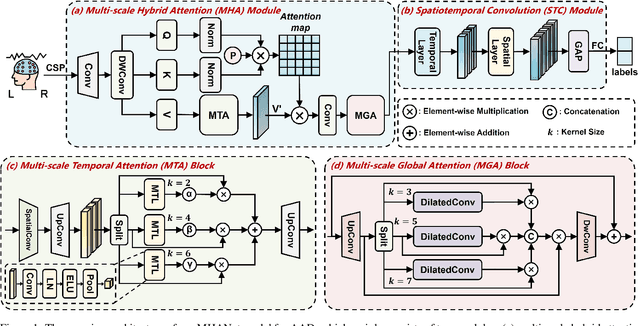
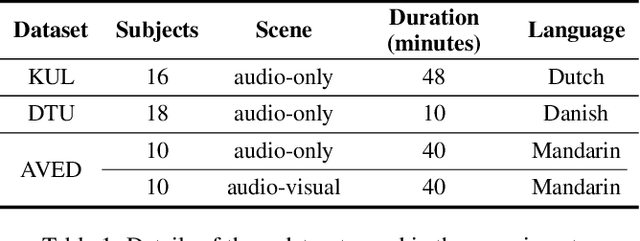
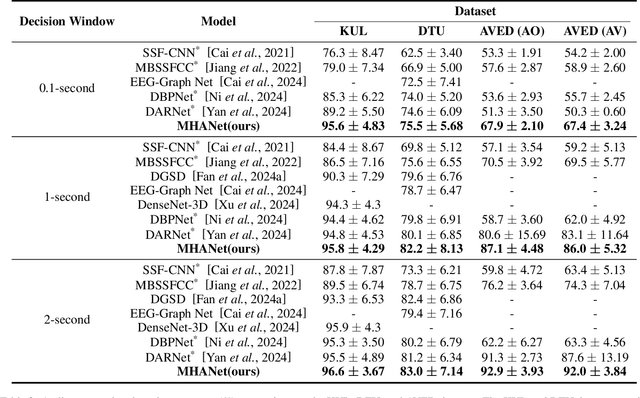
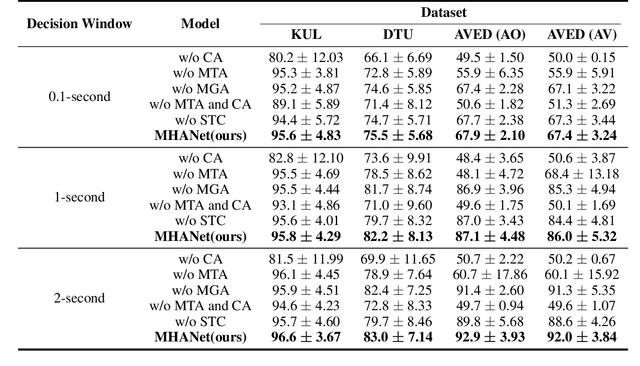
Abstract:Auditory attention detection (AAD) aims to detect the target speaker in a multi-talker environment from brain signals, such as electroencephalography (EEG), which has made great progress. However, most AAD methods solely utilize attention mechanisms sequentially and overlook valuable multi-scale contextual information within EEG signals, limiting their ability to capture long-short range spatiotemporal dependencies simultaneously. To address these issues, this paper proposes a multi-scale hybrid attention network (MHANet) for AAD, which consists of the multi-scale hybrid attention (MHA) module and the spatiotemporal convolution (STC) module. Specifically, MHA combines channel attention and multi-scale temporal and global attention mechanisms. This effectively extracts multi-scale temporal patterns within EEG signals and captures long-short range spatiotemporal dependencies simultaneously. To further improve the performance of AAD, STC utilizes temporal and spatial convolutions to aggregate expressive spatiotemporal representations. Experimental results show that the proposed MHANet achieves state-of-the-art performance with fewer trainable parameters across three datasets, 3 times lower than that of the most advanced model. Code is available at: https://github.com/fchest/MHANet.
ListenNet: A Lightweight Spatio-Temporal Enhancement Nested Network for Auditory Attention Detection
May 15, 2025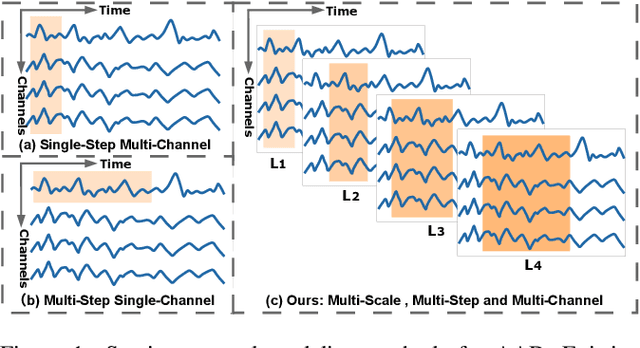

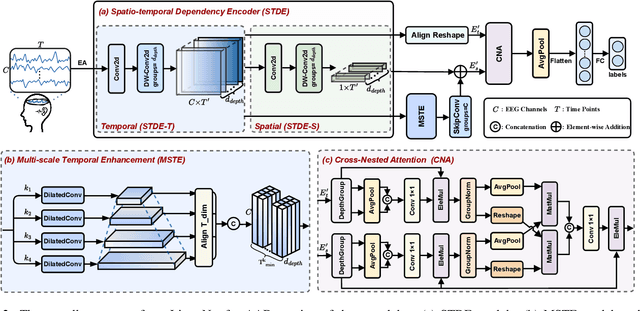
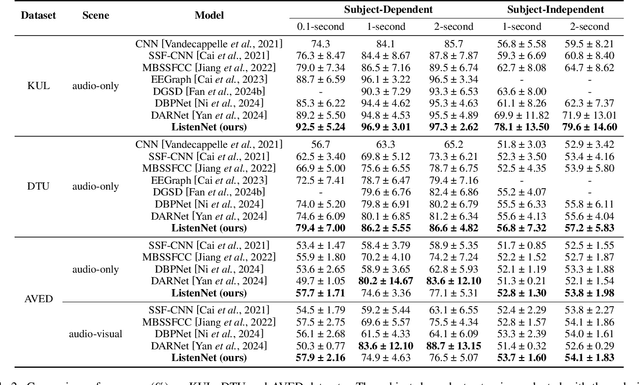
Abstract:Auditory attention detection (AAD) aims to identify the direction of the attended speaker in multi-speaker environments from brain signals, such as Electroencephalography (EEG) signals. However, existing EEG-based AAD methods overlook the spatio-temporal dependencies of EEG signals, limiting their decoding and generalization abilities. To address these issues, this paper proposes a Lightweight Spatio-Temporal Enhancement Nested Network (ListenNet) for AAD. The ListenNet has three key components: Spatio-temporal Dependency Encoder (STDE), Multi-scale Temporal Enhancement (MSTE), and Cross-Nested Attention (CNA). The STDE reconstructs dependencies between consecutive time windows across channels, improving the robustness of dynamic pattern extraction. The MSTE captures temporal features at multiple scales to represent both fine-grained and long-range temporal patterns. In addition, the CNA integrates hierarchical features more effectively through novel dynamic attention mechanisms to capture deep spatio-temporal correlations. Experimental results on three public datasets demonstrate the superiority of ListenNet over state-of-the-art methods in both subject-dependent and challenging subject-independent settings, while reducing the trainable parameter count by approximately 7 times. Code is available at:https://github.com/fchest/ListenNet.
Towards an Understanding of Context Utilization in Code Intelligence
Apr 11, 2025Abstract:Code intelligence is an emerging domain in software engineering, aiming to improve the effectiveness and efficiency of various code-related tasks. Recent research suggests that incorporating contextual information beyond the basic original task inputs (i.e., source code) can substantially enhance model performance. Such contextual signals may be obtained directly or indirectly from sources such as API documentation or intermediate representations like abstract syntax trees can significantly improve the effectiveness of code intelligence. Despite growing academic interest, there is a lack of systematic analysis of context in code intelligence. To address this gap, we conduct an extensive literature review of 146 relevant studies published between September 2007 and August 2024. Our investigation yields four main contributions. (1) A quantitative analysis of the research landscape, including publication trends, venues, and the explored domains; (2) A novel taxonomy of context types used in code intelligence; (3) A task-oriented analysis investigating context integration strategies across diverse code intelligence tasks; (4) A critical evaluation of evaluation methodologies for context-aware methods. Based on these findings, we identify fundamental challenges in context utilization in current code intelligence systems and propose a research roadmap that outlines key opportunities for future research.
MagicComp: Training-free Dual-Phase Refinement for Compositional Video Generation
Mar 18, 2025Abstract:Text-to-video (T2V) generation has made significant strides with diffusion models. However, existing methods still struggle with accurately binding attributes, determining spatial relationships, and capturing complex action interactions between multiple subjects. To address these limitations, we propose MagicComp, a training-free method that enhances compositional T2V generation through dual-phase refinement. Specifically, (1) During the Conditioning Stage: We introduce the Semantic Anchor Disambiguation to reinforces subject-specific semantics and resolve inter-subject ambiguity by progressively injecting the directional vectors of semantic anchors into original text embedding; (2) During the Denoising Stage: We propose Dynamic Layout Fusion Attention, which integrates grounding priors and model-adaptive spatial perception to flexibly bind subjects to their spatiotemporal regions through masked attention modulation. Furthermore, MagicComp is a model-agnostic and versatile approach, which can be seamlessly integrated into existing T2V architectures. Extensive experiments on T2V-CompBench and VBench demonstrate that MagicComp outperforms state-of-the-art methods, highlighting its potential for applications such as complex prompt-based and trajectory-controllable video generation. Project page: https://hong-yu-zhang.github.io/MagicComp-Page/.
 Add to Chrome
Add to Chrome Add to Firefox
Add to Firefox Add to Edge
Add to Edge